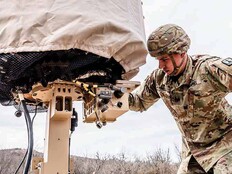CDC, GSA Use RPA to Aid Response
Microsoft announced on March 20 that the Centers for Disease Control and Prevention is using Microsoft’s Healthcare Bot chat service to enable its own COVID-19 assessment bot. The Microsoft bot runs on the company’s Azure cloud platform.
The CDC’s bot “can quickly assess the symptoms and risk factors for people worried about infection, provide information and suggest a next course of action such as contacting a medical provider or, for those who do not need in-person medical care, managing the illness safely at home,” Microsoft says in a blog post.
The idea is that the bot can help alleviate pressure on the country’s hospital and public health systems. “In particular, the need to screen patients with any number of cold or flu-like symptoms — to determine who has high enough risk factors to need access to limited medical resources and which people may more safely care for themselves at home — is a bottleneck that threatens to overwhelm health systems coping with the crisis,” Microsoft notes.
The Defense Logistics Agency is using RPA technology to process FOIA claims more quickly.
Meanwhile, the GSA has deployed a new RPA bot to “speed up collection of infection count data in counties where it manages federal buildings,” FedScoop reports.
GSA owns or leases space in roughly 9,600 buildings in 2,200 communities across the country, FedScoop notes, and is combining county-level infection data with geographic information systems data to visualize the coronavirus threat to its properties. The bot collects data multiple times per day and the feeds it to GSA’s GIS team.
“As the COVID-19 infection counts started rapidly increasing, the level of effort for aggregating all of the COVID-19 infection count data increased exponentially — ultimately requiring several employees to aggregate and process the data,” James Gregory, RPA program director at GSA, tells FedScoop. “Due to this manually intensive process, the GIS team was only able to aggregate and report on the data once a day.”
Employees who had been collecting data are now focused on improving GSA’s map to track infections near government properties it manages.
VIDEO: What are the seldomly asked questions around emerging tech?
CMS Deploys RPA to Help with Telework
Other departments are also increasing their usage of RPA. The Department of Homeland Security has now deployed about 500 bots to perform coronavirus-related data analysis, according to VentureBeat.
The Centers for Medicare and Medicaid Services (CMS) and the Food and Drug Administration are using RPA to help workers engaged in telework, according to FedScoop. They are aiding IT teams with tasks such as patch management and call center support
CMS has also deployed “an employee personnel accountability bot, which will pull data from various internal human resources systems and turn the information into reports,” FedScoop reports. Agency leaders can then use that data to more readily determine which employees are available for higher-priority work.
“This provides the agency with the flexibility to pull information from our separate data systems without doing it manually,” a CMS spokesperson tells FedScoop. “This system will help CMS more efficiently reallocate projects and responsibilities among staff as needed in the wake of the unprecedented COVID-19 pandemic.”











